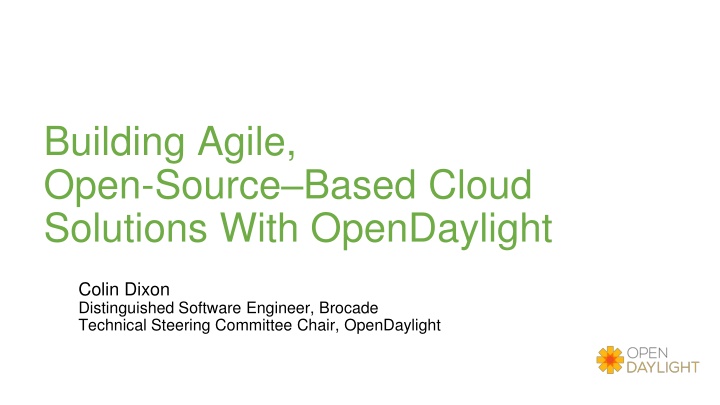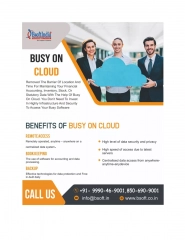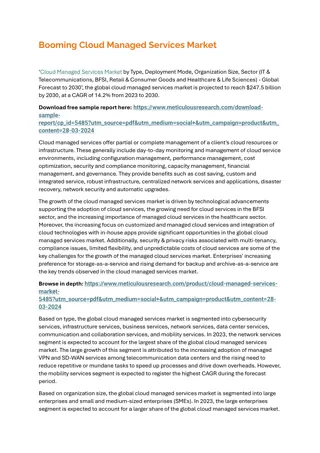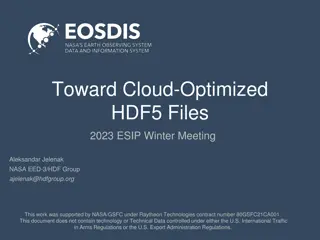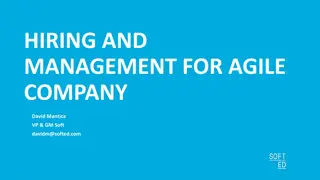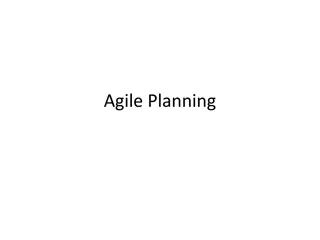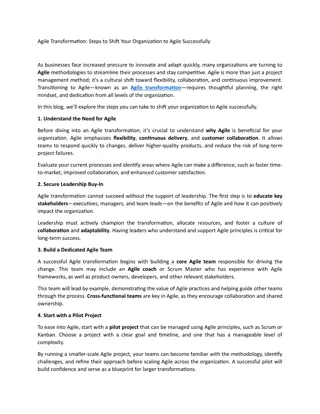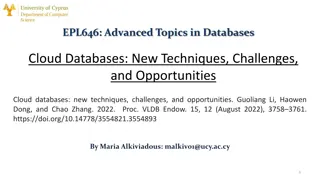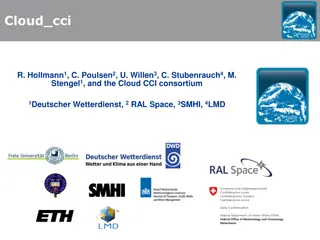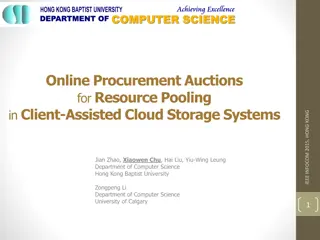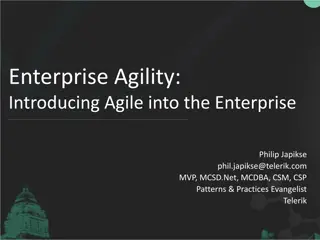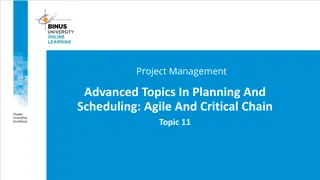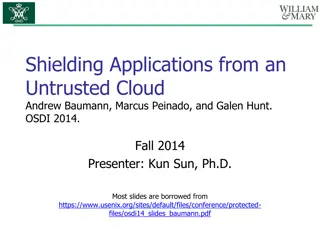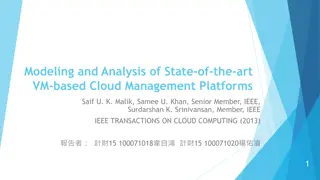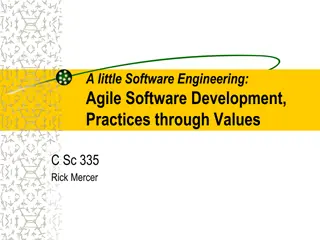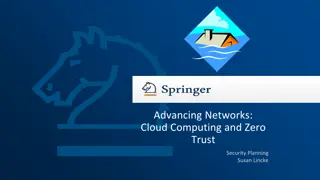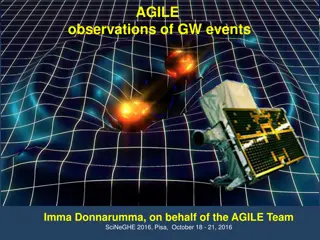Building Agile, Open-Source Cloud Solutions with OpenDaylight
Building Agile, Open-Source Cloud Solutions With OpenDaylight. Decouple elements of the network stack for lower costs and faster innovation. Focus on agility to add features anywhere in the stack independently. Explore the new open networking stack with ORCHESTRATION, Networking Apps, Mgmt./Analytics App, and more. OpenDaylight is now mature with open governance and numerous deployments, fundamentally changing the SDN controller landscape. Discover Boron features and capabilities including integration with industry frameworks and operational tooling. Explore the OpenStack/OpenDaylight integration for scalable network virtualization in OpenStack.
Download Presentation

Please find below an Image/Link to download the presentation.
The content on the website is provided AS IS for your information and personal use only. It may not be sold, licensed, or shared on other websites without obtaining consent from the author.If you encounter any issues during the download, it is possible that the publisher has removed the file from their server.
You are allowed to download the files provided on this website for personal or commercial use, subject to the condition that they are used lawfully. All files are the property of their respective owners.
The content on the website is provided AS IS for your information and personal use only. It may not be sold, licensed, or shared on other websites without obtaining consent from the author.
E N D
Presentation Transcript
Building Agile, Open-Source Based Cloud Solutions With OpenDaylight Colin Dixon Distinguished Software Engineer, Brocade Technical Steering Committee Chair, OpenDaylight
Weve been building SDN for years Commercially since at least 2012 Why? Decouple elements of the network stack: lower (cost) faster innovation (Agility): quickly get new features with minimum dependence on others How are we doing?
Lets focus on (agility) We need to be able to add features Anywhere in the stack Without help from others And deal with the consequences of the chagnes
The new open networking stack ORCHESTRATION (NFVO, ...) Networking Apps Mgmt / Analytics App ECOMP Rest API SDN Platform YANG OpenFlow Netconf Custom BGP OVSDB Open NOS VMs / Cont. Legacy HW HW HW Optical
OpenDaylight Now Mature, Open Governance 800+ Contributors Over 100 deployments Leading use cases identified Dozens of ODL-based solutions Mature code base Focus on performance, scale and extensibility OpenDaylight fundamentally changed the Linux Foundation s world. It s been wildly successful. It s the de facto standard open source SDN controller for the industry today. - Dave Ward, Cisco CTO *SDxCentral, 9/7/16
Boron Features and Capabilities Integration - industry frameworks OPNFV OpenStack enhancement CORD/vCO ECOMP ONF/Atrium Operational tooling Cardinal health monitoring Data analytics (TSDR & Centinel) OCP (Open radio I/F) Documentation App developer tooling YANG-IDE toolkit NetIDE for cross-OSS controller interoperability NeXt UI toolkit Singleton app HA Documentation Common SDN toolchains Net Virtualization + SFC: OF + OVSDB + OVS/FD.io Mgmt plane programmability: BGP + PCEP + MPLS + NETCONF
OpenStack/OpenDaylight Integration Multiple Neutron implementations Target different use cases, southbound drivers FD.io/VPP OVS Open Overlay Router (n e LISPmob) Provide distributed implementations of scalable network virtualization for OpenStack
OpenStack/OpenDaylight Integration L2: ML2 plugin L3: ODL L3 plugin services FWaaS L2Gateway QoS LBaaS BGPVPN networking-sfc trunk Neutron Server Service Plugins ML2 Plugin Mechanism Manager ODL L3 Plugi n QoS Type Manager ... FWaaS L2GW driver ODL mech SR-IOV ODL driver ODL driver ODL driver TypeDriver TypeDriver TypeDriver VXLAN VLAN GRE ... ... ... ... ... networking-odl
What does Central Office do? Subscriber management capabilities: Gateway, authentication and authorization, event and subscriber information logging Optical Line Termination (OLT) for PON/GPON (Passive Optical Net.) Service functions: self-service portals, NAT, FW, routing, IP addr mgmt, QoS, quotas, video caching, mail and file stores A Virtualized Central Office (vCO): Uses general-purpose compute, storage and network capabilities to deliver the above services Added agility (spin up VMs vs. rack and stack hardware) Cost savings (via increased automation and commodity servers)
vCO Data Center Architecture Physical elements are divided into Network: provides fabric/underlay Servers: provides computer/storage for VNFs N o r t h - S o u t h Fabric/Underlay (Network) VM Servers/VNFs (Compute, Storage) VM VM VM VM VM VM VM VM VM VM VM VM VM VM VM VM VM VM VM VM VM VM VM East West WAN WAN
vCO Data Center Architecture Controllers and orchestrators use overlay networks to form service chains of VNFs N o r t h - S o u t h VM VNF VNF VNF VM VM VM VM VM VM VM VM VM VM VM VM VM VM VM VNF VM VNF VM VM VM VM VM VM VM East West WAN WAN
vCO Data Center Software Architecture OSS/BSS Policy (NIC, NEMO, GBP, Neutron) VNFO (ECOMP, Open-O, OSM, ) Service Chaining Overlay Network VNF Spec (TOSCA) VNF Catlog Fabric VNFM (Tacker, Cloudify, ) SDN Controller (OpenDaylight) VIM (OpenStack, Kubernetes, ) Fabric/Underlay (Network) VM Servers/VNFs (Compute, Storage) VM VNF VNF VNF VM VM VM VM VM VM VM VM VM VM VM VM VM VM VM VNF VM VNF VM VM VM VM VM VM
ROBO: Using vCO Blueprint in Enterprises vCO for Enterprises to provide for Remote/Branch offices Maybe offered by ISPs as a service Integrating with public cloud will likely involved some form of vCO (either aaS or Enterprise-deployed) Hybrid Cloud will almost certainly involve vCO Automating this requires integration with many other projects and legacy devices (NETCONF + BPG + MPLS + PCEP) vCOaaS from ISP Private Cloud Remote Office Main Office Public Cloud vCO to connect backends Branch Office
Think Beyond the Controller Product Enabling solution component
